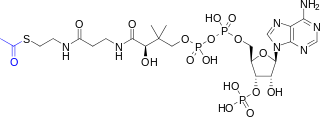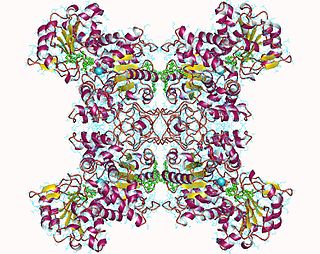
Glycolysis is the metabolic pathway that converts glucose into pyruvate, and in most organisms, occurs in the liquid part of cells, the cytosol. The free energy released in this process is used to form the high-energy molecules adenosine triphosphate (ATP) and reduced nicotinamide adenine dinucleotide (NADH). Glycolysis is a sequence of ten reactions catalyzed by enzymes.

Acetyl-CoA is a molecule that participates in many biochemical reactions in protein, carbohydrate and lipid metabolism. Its main function is to deliver the acetyl group to the citric acid cycle to be oxidized for energy production. Coenzyme A consists of a β-mercaptoethylamine group linked to the vitamin pantothenic acid (B5) through an amide linkage and 3'-phosphorylated ADP. The acetyl group of acetyl-CoA is linked to the sulfhydryl substituent of the β-mercaptoethylamine group. This thioester linkage is a "high energy" bond, which is particularly reactive. Hydrolysis of the thioester bond is exergonic (−31.5 kJ/mol).

Pyruvate carboxylase (PC) encoded by the gene PC is an enzyme of the ligase class that catalyzes the physiologically irreversible carboxylation of pyruvate to form oxaloacetate (OAA).

1-Pyrroline-5-carboxylic acid is a cyclic imino acid. Its conjugate base and anion is 1-pyrroline-5-carboxylate (P5C). In solution, P5C is in spontaneous equilibrium with glutamate-5-semialdhyde (GSA).

Malate dehydrogenase (decarboxylating) (EC 1.1.1.39) or NAD-malic enzyme (NAD-ME) is an enzyme that catalyzes the chemical reaction

In enzymology, a pyruvate synthase is an enzyme that catalyzes the interconversion of pyruvate and acetyl-CoA. It is also called pyruvate:ferredoxin oxidoreductase (PFOR).

In enzymology, an alanine racemase is an enzyme that catalyzes the chemical reaction
In enzymology, an acetylpyruvate hydrolase (EC 3.7.1.6) is an enzyme that catalyzes the chemical reaction
In enzymology, a phosphonopyruvate hydrolase (EC 3.11.1.3) is an enzyme that catalyzes the chemical reaction
The enzyme 4-hydroxy-4-methyl-2-oxoglutarate aldolase catalyzes the chemical reaction
In enzymology, a urea carboxylase (EC 6.3.4.6) is an enzyme that catalyzes the chemical reaction
In enzymology, a 5'-acylphosphoadenosine hydrolase (EC 3.6.1.20) is an enzyme that catalyzes the chemical reaction

In enzymology, an acylphosphatase (EC 3.6.1.7) is an enzyme that catalyzes the hydrolysis of the carboxyl-phosphate bond of acylphosphates, with acylphosphate and H2O as the two substrates of this enzyme, and carboxylate and phosphate as its two products:
The enzyme hydroxyacylglutathione hydrolase (EC 3.1.2.6, systematic name = S-(2-hydroxyacyl)glutathione hydrolase) catalyzes the following reaction:
In enzymology, a 1-aminocyclopropane-1-carboxylate deaminase (EC 3.5.99.7) is an enzyme that catalyzes the chemical reaction
In enzymology, a 1-pyrroline-4-hydroxy-2-carboxylate deaminase (EC 3.5.4.22) is an enzyme that catalyzes the chemical reaction
In enzymology, a 5-oxoprolinase (ATP-hydrolysing) (EC 3.5.2.9) is an enzyme that catalyzes the chemical reaction
In enzymology, an allophanate hydrolase (EC 3.5.1.54) is an enzyme that catalyzes the chemical reaction
In enzymology, a hydroxyisourate hydrolase (EC 3.5.2.17) is an enzyme that catalyzes the chemical reaction

In enzymology, a nicotinate-nucleotide diphosphorylase (carboxylating) (EC 2.4.2.19) is an enzyme that catalyzes the chemical reaction









